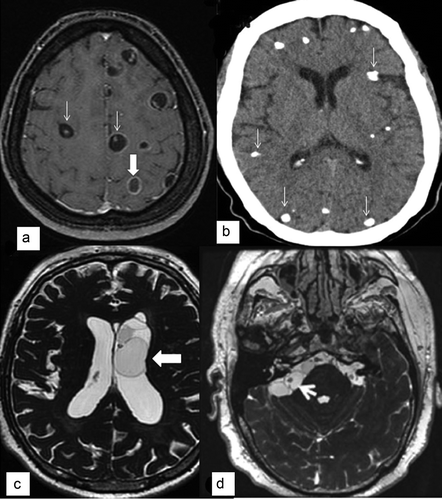Figures & data
Table 1. Differences between parenchymal and extraparenchymal neurocysticercosis.
Figure 1. Imaging of parenchymal and extraparenchymal neurocysticercosis.
(A) MRI post-gadolinium T1 sequence showing viable cysts with scolex (thin arrows) and a transitional or degenerative-choloidal cyst (wide arrow).(B) CT scan showing multiple parenchymal calcifications (arrows).(C) 3D MRI sequence (FIESTA) showing cysts into the left ventricle (arrow).(D) 3D MRI sequence (FIESTA) showing cysticerci at the right cerebellopontine cistern (arrow).

Figure 2. Multifactorial basis of epilepsy in patients with neurocysticercosis. (A) Three factors involved in epileptogenesis in NC. (Top) Sinuous line indicates seizure threshold or propensity for a seizure to occur. (Middle) Represents structural lesion due to the parasite evolutionary phase that changes over time: a, viable; b, colloidal; c, granular-nodular; and d, calcified cyst. The evolution of cysts phases lasts around 6 months on average, from the viable to calcified stage. (Bottom) Arrows illustrate potential precipitating factors or a cascade of mechanisms that may contribute to trigger seizures. Someone with a high threshold may have parasitic epileptogenic lesions and never have seizures (i.e. asymptomatic patients). (B) Someone with a low threshold could have acute seizures, as indicated by the red lines around the cysts (i.e. ictogenesis) due to parasitic epileptogenic lesions and precipitating factors, and seizures recur over time since there is a genetic predisposition to maintain low threshold (i.e. epileptogenesis). (C) Someone with a low threshold could have acute seizures due to parasitic epileptogenic lesions and precipitating factors, but seizures do not recur, since there is no genetic predisposition to maintain a low threshold and they do not evolve into epilepsy. Republished with permission from [Citation51].
![Figure 2. Multifactorial basis of epilepsy in patients with neurocysticercosis. (A) Three factors involved in epileptogenesis in NC. (Top) Sinuous line indicates seizure threshold or propensity for a seizure to occur. (Middle) Represents structural lesion due to the parasite evolutionary phase that changes over time: a, viable; b, colloidal; c, granular-nodular; and d, calcified cyst. The evolution of cysts phases lasts around 6 months on average, from the viable to calcified stage. (Bottom) Arrows illustrate potential precipitating factors or a cascade of mechanisms that may contribute to trigger seizures. Someone with a high threshold may have parasitic epileptogenic lesions and never have seizures (i.e. asymptomatic patients). (B) Someone with a low threshold could have acute seizures, as indicated by the red lines around the cysts (i.e. ictogenesis) due to parasitic epileptogenic lesions and precipitating factors, and seizures recur over time since there is a genetic predisposition to maintain low threshold (i.e. epileptogenesis). (C) Someone with a low threshold could have acute seizures due to parasitic epileptogenic lesions and precipitating factors, but seizures do not recur, since there is no genetic predisposition to maintain a low threshold and they do not evolve into epilepsy. Republished with permission from [Citation51].](/cms/asset/b7a95f40-c4f1-4f31-99a4-f45e1f5a25c5/iern_a_1451328_f0002_oc.jpg)
Table 2. New diagnostic criteria for symptomatic neurocysticercosis.
Table 3. Treatment of neurocysticercosis.
Table 4. Controlled clinical trials regarding effects of albendazole on resolution of viable parenchymal cysts and seizures recurrence.
